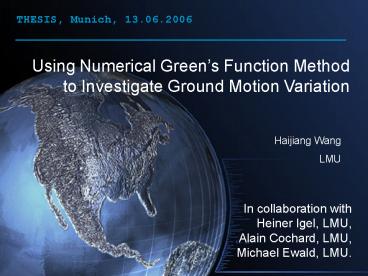THESIS, Munich, 13.06.2006 - PowerPoint PPT Presentation
Title:
THESIS, Munich, 13.06.2006
Description:
THESIS, Munich, 13.06.2006 Using Numerical Green s Function Method to Investigate Ground Motion Variation Haijiang Wang LMU In collaboration with Heiner Igel, LMU ... – PowerPoint PPT presentation
Number of Views:117
Avg rating:3.0/5.0
Title: THESIS, Munich, 13.06.2006
1
THESIS, Munich, 13.06.2006
Using Numerical Greens Function Method to
Investigate Ground Motion Variation
Haijiang Wang LMU
In collaboration with Heiner Igel, LMU, Alain
Cochard, LMU, Michael Ewald, LMU.
2
Outline
- Motivation (source related ground motion
uncertainty) - Numerical Greens Function approach
- Uncertainty due to hypocentre location
- Uncertainty due to varying slip distribution
- Conclusions
3
Motivation
Basin effect
But few attention was paid on source complexity
(3D) ...
4
Motivation
- For large earthquake, point source is not
sufficient and at least kinematic finite source
is necessary to describe the source process - Special attention should be paid to the
directivity - Source complexity
- Static displacement (asperity)
- Rupture velocity
- Slip velocity
5
Numerical Greens Function
- Theory
- Optimal largest subfault size
- Study area and fault
- Database created
6
Numerical Greens Function
Theory
7
Numerical Greens Function
Optimal subfault size homogeneous case
Spatial discretization (km) 1000
Temporal discretization (s) 0.0822
S-wave velocity (km/s) 3.9
Simulation time (s) 50
Study area (km) 150130x60
PML Nodes 10
Constant slip rate (m/s) 1
- Accuracy increases with the increase of
- cut-off frequency
- rupture velocity
- magnitude
8
Numerical Greens Function
Study area
N
SCEC cvm version3
9
Numerical Greens Function
Newport Inglewood Fault
- M6.4 Long Beach earthquake in 1933 (Hauksson and
Gross, 1991) - Probable source for a damaging earthquake
- Near-vertical plane and predominant right-lateral
slip (SCEC cfm)
10
Numerical Greens Function
Verification heterogeneous case
subfault size 1.5 km can be applied as the
principal subfault size to the generation of the
NGF data base
Spatial discretization 300 m
Temporal discretization 0.018 s
Lowest S-wave velocity 1.4 km/s
Simulation time 65
Number of cells 550500x150
PML Nodes 10
Magnitude 7.0
Fault dimension 16 x36 km
11
Numerical Greens Function
Database
Spatial discretization (km) 0.300
Temporal discretization (s) 0.01811
Lowest S-wave velocity (km/s) 1.400
Simulation time (s) 65
Number of cells 550500x150
Fault length dimension (km) 6019
Surface grid distance (m) 600
Ground motion components 6
Total database size (Tb) 1.5
12
Summary 1
- Equation for synthesization of NGFs is developed.
- Optimal subfault size is investigated both for
homogeneous media and heterogeneous media. - Database is created for the Newport Inglewood
fault embedded in the Los Angeles basin with
appropriate setup.
13
Uncertainty - Hypocentre
- Outline
- Motivation
- Hypocentre locations
- Velocity snapshots
- Basin amplification
- PGV characteristics variation with hypocentre
location
14
Uncertainty - Hypocentre
Static displacement and hypocentres
Guatteri et al., 2005
15
Uncertainty - Hypocentre
Velocity snapshots
16
Uncertainty - Hypocentre
- Velocity Profiles
17
Uncertantity - Hypocentre
PGV characteristics
18
Uncertantity - Hypocentre
Varying source depth
19
Summary 2
- Horizontal hypocentre variation influences the
ground motion - Vertical hypocentre variation has only slight
influence on the ground motion - In the area far from the fault, the medium plays
main role on ground motion variation while in the
area very close to the fault plane the hypocentre
does
20
Uncertainty - Slip
- Outline
- Quasi-dynamic rutpure process generation
- Directivity effect
- Slip variation effect
- PGV characteristics
21
Uncertantity - Slip
Quasi-dynamic rutpure process
22
Uncertantity - Slip
Wang et al., 2006, submitted to ESG
23
Uncertantity - Slip
Directivity
24
Uncertantity - Slip
Different directivity on different components
the fault perpendicular component is dominated by
the directivity effect and the fault parallel and
vertical components have significant contribution
from the 3-D structure (basin effects) and slip
distribution.
Wang et al., 2006, submitted to ESG
25
Uncertantity - Slip
Three individual slips
Wang et al., 2006, submitted to ESG
26
Uncertantity - Slip
PGV characteristics maximum value and standard
deviation
Wang et al., 2006, submitted to ESG
27
Summary 3
- Directivity effect dominates the fault
perpendicular component - Fault parallel and vertical components have
significant contribution from the 3-D structure
(basin effects) and slip distribution. - Slip asperity elevates the ground motion in its
nearby area. - The maximum seismic motion variation on the
surface is dominated by directivity.
28
Conclusions
- We investigate the ground motion variations due
to sets of parameters using our new-developed
method Numerical Greens Function - Horizontal hypocentre location variations
influence the ground motion. - Dominant directivity effect on the fault
perpendicular component is confirmed by our
simulations while fault parallel components are
controled by both the source properties and the
basin structure, for this specific case. - Slip asperity elevates the ground motion in its
nearby area. - The maximum seismic motion variation on the
surface is dominated by directivity.
29
Future Works
- Investigation of rotational motions
- Peak rotational motions
- Attenuation relations for rotations
- Source vs. 3D effects for rotations
30
End Thanks































